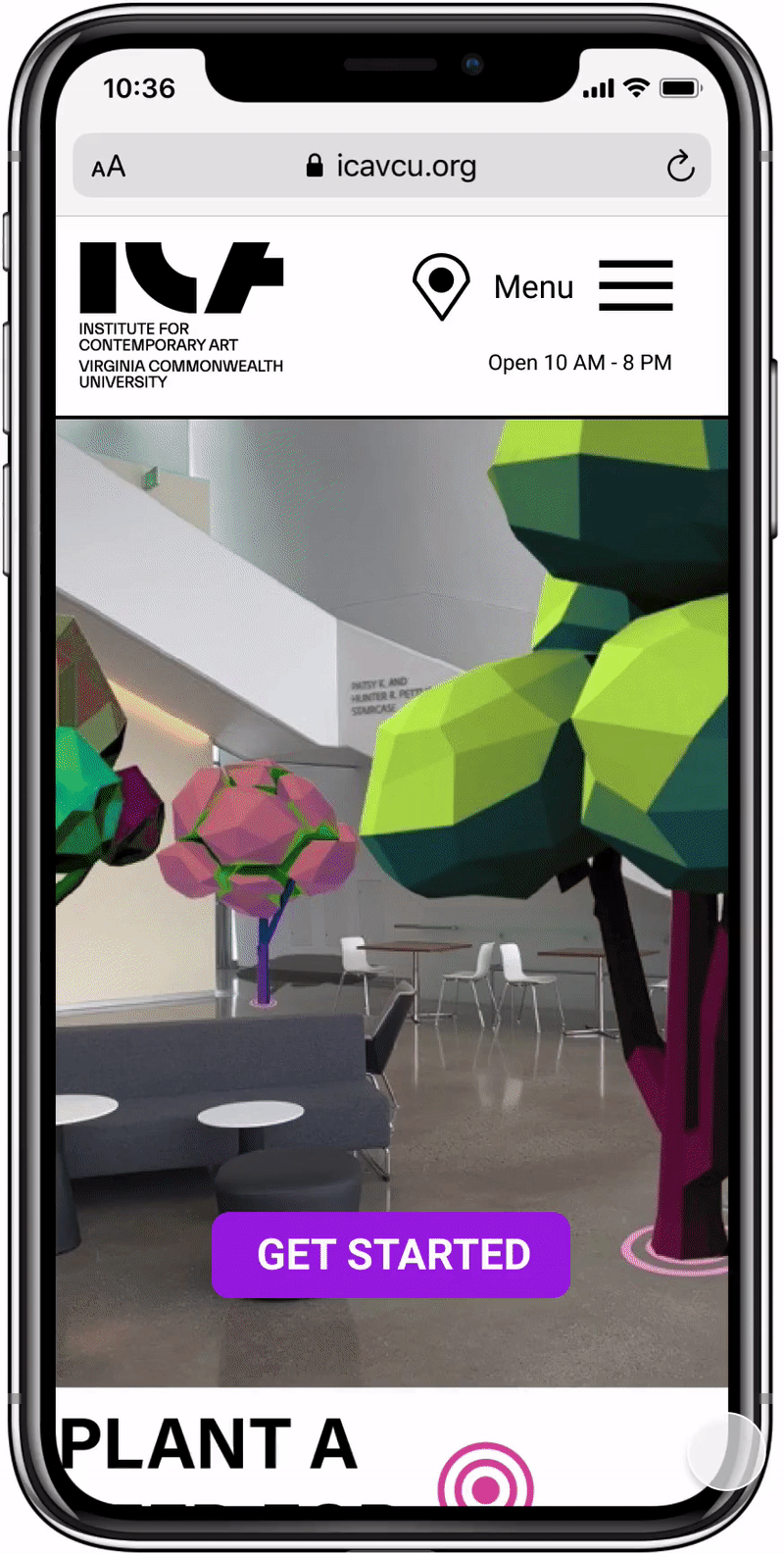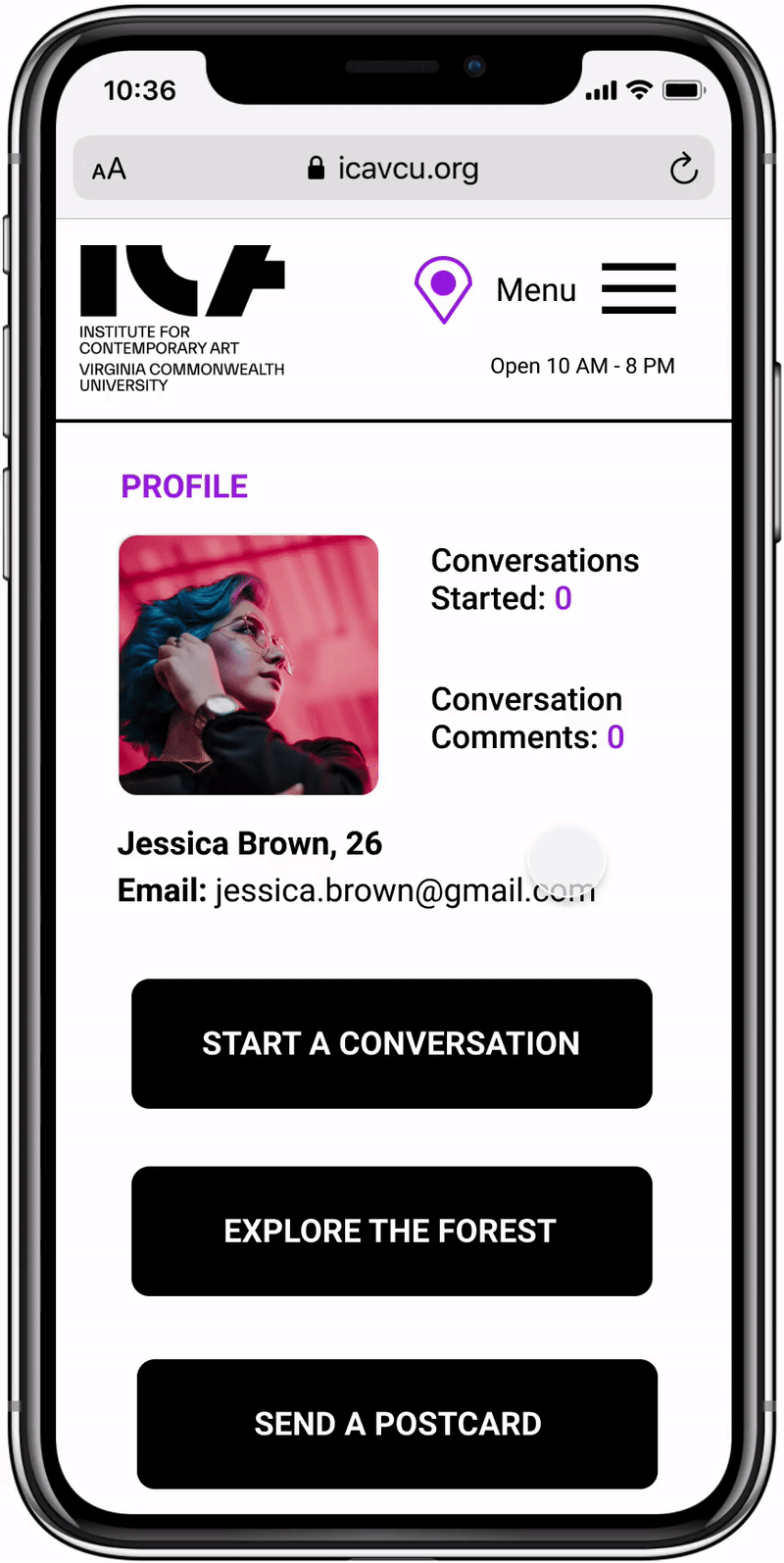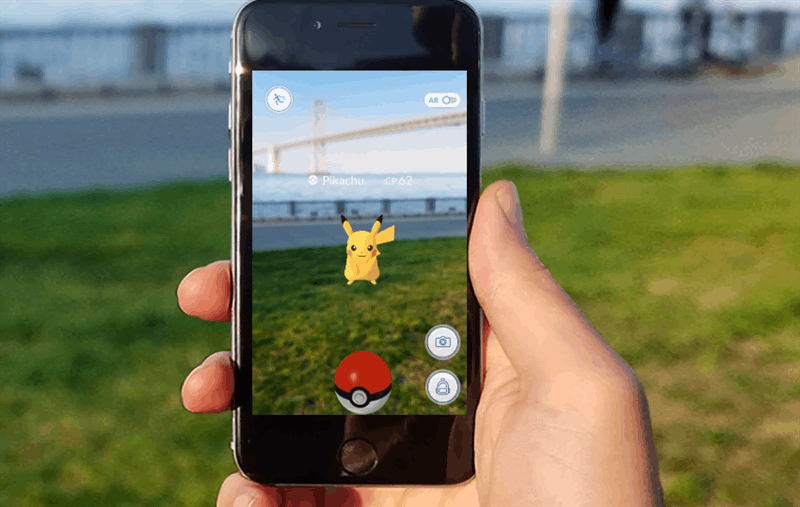
THE FOREST
AR EXPERIENCE
BY

How might the ICA promote and facilitate interactivity within its walls?
By implementing augmented reality into their visitor experience.
RESEARCH, BRAND INNOVATION, STRATEGY, UX/UI, USER TESTING, PRODUCT DESIGN
PROJECT OVERVIEW
This team project was completed in my 1st semester of grad school for a live client. Our team created an augmented reality experience for the ICA that allows visitors to contribute. to topical and relevant conversations surrounding contemporary art within their atrium.
MY ROLE
I conducted research on the brand and the category at large, synthesized the research into user insights, helped develop the strategy and concept for the project. I designed the user journey and user-tested the UX/UI for the experience.
THE ASK
How can the ICA enhance its street-level atrium, the Forum, to promote interaction and collaboration among the many visitors and communities it serves?
THE CHALLENGE
Just like Richmond, the ICA struggles to create spaces that are safe enough for people to engage across various divides like race, age, or gender.
THE SOLUTION
An interactive experience within the Forum, that uses A.R. as a platform to facilitate visitor conversations about the exhibitions and the ICA in a more approachable and unexpected way.
INTRODUCING. . .

THE FOREST
An A.R. experience that uses visual metaphor. The ICA is a place where conversations are cultivated through planting seeds for discussion. Trees of conversation grow in the Forum through the addition of comments.
Hover to Uncover the Forest
KEY FEATURES
Start a Conversation
Conversations are started by submitting a seed for conversation about the art or the ICA. If approved it is planted in the Forum as a seedling.


Explore and Contribute
Share the Experience
A.R.-activated postcards are available for visitors to send out in order to share their experience with others.
Visitors can explore the forest of conversations growing in the Forum, add to a conversation, or check in on a conversation they started.

USER JOURNEY
1-Discovering
3-Onboarding
5-Exploring
2-Priming
4-Planting
6-Repeating


01. Discovery
Jessica receives a postcard in the mail from a friend. She visits the ICA website, and sees her postcard come to life—a tree grows out of the card! She’s surprised and filled with joy. She now wants to visit the ICA to explore the new A.R. experience.
02. Priming Visitor
A few days later, Jessica goes to the ICA. When she approaches the building she sees signage for the A.R. experience. She’s interested to see what’s happening inside but unsure if she’s ready to commit to participating because she is alone.



03. Onboarding
Upon entering the building, she is greeted by a Visitor Education Assistant standing behind the front desk. He warmly welcomes her. She’s feeling more comfortable and asks him how the A.R. experience works. He walks her through the onboarding process: creating a profile, starting conversations, and how to explore the forest. She’s intrigued, engaged, and ready to participate.
04. Plant a Seed
Jessica views the great force exhibition. While she is in the exhibition she has a provocative thought and feels empowered to start a conversation. She creates a seed to be planted as a conversation seedling in the Forum. She is comfortable sharing her thoughts through the virtual platform.




05. Add a Comment
Jessica returns to the forum, she is excited to explore the forest of conversations. She notices that her conversation starter has been planted in the forum! Jessica is shocked as she sees the forest come to life. So many conversations are taking place; there is so much to explore. She contributes to a conversation and feels like a part of a community bigger than herself.
06. Continual Journey
Before leaving the ICA, Jessica wants to share her experience with a friend. The ICA has created new meaning and value in Jessica’s life. She leaves with a new perception of the ICA and its art. The experience framed the ICA as a destination. The cycle continues as more people receive postcards. The ICA builds trust through leveraging social networks of trust.

BACKGROUND
Art is culture.
The Institute of Contemporary Art (ICA) at Virginia Commonwealth University's mission is to present the art of our time and provides an open forum for dialogue and collaboration across the region and throughout the world.
Based on the Radical Listening Report: a study conducted by the ICA in 2017, it was apparent that the ICA could be a gathering space for conversations, or dialogue, that could tackle these kinds of challenging topics with honesty and boldness.
But Contemporary Art can be intimidating and unapproachable.
The ICA opened in April 2018, it showcases an ever-changing slate of exhibitions, performances, and film in a wide array of mediums. The building was strategically built at the busy intersection of Belvidere and Broad street—it serves as a gateway between the campus and Monroe Ward. It occupies an area with a rich and complex socio-economic and racial history.
To have the best experience, the ICA must lower the threshold to allow visitors to connect over shared interests and topics.
A forum metaphorically is a number of things: it’s a threshold, a bridge, a portal. It is a space with inherent cultural tension where ideas are shared and conversations take place. The ICA’s Forum has the potential to be the place that bridges the Richmond and VCU communities—making the ICA a cultural pillar in Richmond. The ability to engender trust between visitors and the ICA as a cultural institution that routinely offers a variety of unexpected experiences.
BRAND OPPORTUNITY
The ICA has the opportunity to position itself as more than an art museum with passive visitor experiences. By stepping into the space of interactivity and breaking down the “4th wall” the ICA will allow the visitor to have a more personalized and active experience within the institution. The ICA would be able to occupy a brand new space in the Richmond art landscape as the only institution applying an interactive digital layer to their physical experience.
UNIQUE CHALLENGES
The ICA is a non-collecting institution.
Unlike most institutions/museums that own, display, and archive the work on exhibit; all work exhibited at ICA is owned by the artists or made collaboratively with the institution for the exhibition. This ever-changing environment never allows a visitor to become familiar with the art on exhibition.
Contemporary Art can be intimidating.
In comparison to other genres of art, contemporary art is typically rooted in conceptual ideas and expressed in an abstract, jarring or uncomfortable maner.
Art institutions are perceived as spaces for solitary reflection.
While visiting, many visitors don’t feel empowered to participate in discussions if they are alone, uncomfortable or not as informed.

USER PAIN POINTS
A lack of clear communication between the institution, its staff, and the visitor due to information barriers.
Visitors want to get outside of their “bubble”, but currently there isn’t a low-risk/anonymous way to achieve this.
Visitors don’t know where the ICA fits into the Richmond community; thus, they don’t know how to interact with the institution.
A lack of individualized viewing experience or approachable platforms for open discussion.
USER PERSONA
Our user persona Jessica is an amalgamation of all the people who participated in our user testing and survey as well as those who participated in the ICA’s two Radical Listening Reports. She does not consider herself an art expert, but she has an interest in art, culture, and connecting with others. We see her as an example of an earlier adopter and participant of “The Forest” experience.
About: She is a proactive community member who is willing to initiate conversation and engagement with challenging topics when she is comfortable. She goes to art galleries and museums regularly.
Goals: She wants to explore more art in the Richmond area. She is eager to engage in important conversations surrounding her community as well, but she is apprehensive to contribute to discussions when she is alone. She also intends to spread the conversation to her friends.
Tech & Social Media: Average social media user, posts on Instagram and other social media at least once a week.
Challenges: She often does not have the time to converse with friends about important topics. She often goes to galleries and exhibits alone.
Favorite platforms: iPhone, Instagram, safari

Jessica Brown, 26
Young professional
DESIGN PROCESS
INSPIRATION
We drew inspiration from digital products that promote real-time exploration and discovery ( Like Pokemon Go) and from existing A.R. experiences (like the SF MOMA and the Science Museum of Oklahoma) that help visitors learn more about art and exhibitions.



RESEARCH
Key insights were gathered from primary research, which included two ethnographic studies conducted by the ICA and a survey conducted by our team, and secondary research focused on A.R. experiences, museum take-aways, and A.R. trends in museums.
Key Insights
ICA Radical Listening Study
-
60% were women
-
45% were non-white
-
Importance of addressing divisions of race, culture, and socio-economic status.
-
ICA could play an educational role and provide opportunities for learning.
-
50% were students
-
44% were under 35
-
An opportunity to create a safe space to have 'risky conversations'.
-
Participants had an interest in focusing on curiosity and discovery.
Science Museum of Oklahoma
-
77% of people viewed all 19 pieces of A.R. content
-
63% of people (visitors) had never seen A.R.
-
The average time spent at the museum doubled.
-
657 app downloads
-
They experienced repeat visitors, saw physical reactions from all ages, and more visitor-visitor interactions.
SAMPLE SURVEY QUESTIONS



BRAND IDENTITY

Icons
WIREFRAMES

PROTOTYPED MOBILE WEB FLOW
